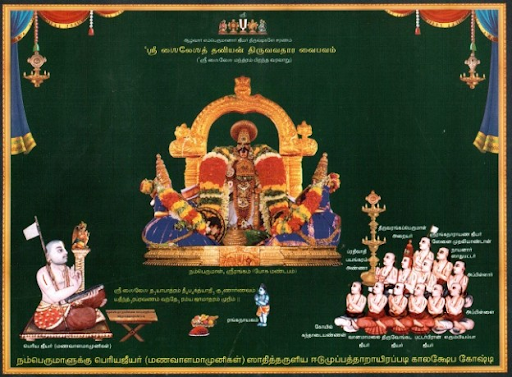Moha Mudgara (Destroyer of illusion) is a popular Hindu devotional poem in Sanskrit composed by Adi Shankara. This work of Adi Shankara underscores the view that Bhakti (devotion) is also important part along with Jnana (knowledge), as emphasised by the bhakti movement. A popular rendition sung by M. S. Subbulakshmi begins with the shloka । स्थापकाय च धर्मस्य सर्वधर्म-स्वरूपिणे ।। अवतार-वरिष्ठाय रामकृष्णाय ते नमः ॥ meaning "(Salutations) to the establisher of Dharma who is of the essence of all of nature; salutations to that great incarnation of the form of Ramakrishna."
There is a story related to the composition of this Hymn. It is said that Shri Adi Shankaracharya, accompanied by his disciples, was walking along a street in Varanasi one day when he came across an old aged scholar reciting the rules of Sanskrit grammar of Panini repeatedly on the street. Taking pity on him, Adi Shankara went up to the scholar and advised him not to waste his time on grammar at his age but to turn his mind to God in worship and adoration, which would only save him from this vicious cycle of life and death. The hymn "Bhaja Govindam" is said to have been composed on this occasion.
This composition is a reminder that Adi Shankaracharya, who is often regarded as reviver of Hinduism Jnana Marga or the "Path of Knowledge" to attain Mukti also was a proponent of Bhakti Marga (Bhakti Yoga) to attain the same goal, and as C Rajagopalachari put in his commentary, "When intelligence (jnana) matures and lodges securely in the heart, it becomes wisdom (vignyana). When that wisdom (vignyana) is integrated with life and issues out in action, it becomes devotion (bhakti). Knowledge (jnana) which has become mature is spoken of as devotion (bhakti). If it does not get transformed into devotion (bhakti), such knowledge (jnana) is useless tinsel."
In this prayer, Adi Shankaracharya emphasizes the importance of devotion for God as a means to spiritual development and to liberation from the cycle of birth and death. The prayer leaves one in no doubt that the renunciation of our egotistical differences and surrender to God makes for salvation. Many scholars hold that this composition encapsulates with both brevity and simplicity the substance of all Veantic thought found in whatever other works that Adi Shankaracharya wrote:
The refrain "Bhaja Govindam" which defines the composition and gives it its name invokes the almighty in the aspect of supreme god Shree Krishna; it is therefore very popular not only with Sri Adi Shankaracharya's immediate followers, the Smarthas, but also with Vaishnavas and others.
Govinda (also known as Govind and Gobind) are the names of Vishnu. The name appears as the 187th and the 539th name of Lord Vishnu in Vishnu Sahasranama. Lord Vishnu or his complete incarnation Krishna are regarded as the Supreme God in the Vaishnava tradition and also by much of the pan-Hindu tradition. The name is also popularly addressed to Krishna, referring to his youthful activity as a cowheard boy.
Govinda has four meanings
- The sages call Krishna "Govinda" as He pervades all the worlds, giving them power.
- The Shanti Parva of the Mahabaratha states that Vishnu restored the earth that had sunk into the netherworld, or naraga in Tamil, so all the devas praised Him as Govind (Protector of the Land).
- Alternatively, it means "He who is known by Vedic words alone".
- In the Harivamsha, Indra praised Krishna for having attained loving leadership of the cows which Krishna tended as a cowherd, by saying, "So men too shall praise Him as Govinda."
Maharishi Mahesh Yogi, in his commentary on the Bhagavad-Gita, states that Govinda means "master of the senses". In the Mahabharata, when Draupadi's saree was stripped by Dhushasana in the court of Hastinapura, it is said that Draupadi prayed towards Lord Krishna (who was in Dwaraka at that time) invoking him as "Govinda" at the instance of extreme distress where she could no longer hold her saree to her chest. For this reason, it is believed that "Govinda" is how the Lord is addressed by devotees when they have lost it all and have nothing more to lose. This may be the reason why in colloquial Tamil and Telugu the slang-term "govinda" sometimes refers to the prospect of losing or failing in something important.


